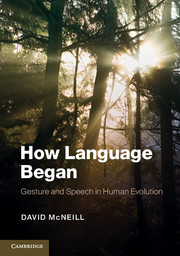Book contents
- Frontmatter
- Contents
- List of figures
- List of tables
- Preface – Out on a limb
- Acknowledgments
- 1 INTRODUCTION – GESTURE AND THE ORIGIN OF LANGUAGE
- 2 What evolved (in part) – the growth point
- 3 How it evolved (in part) – Mead's Loop
- 4 Effects of Mead's Loop
- 5 Ontogenesis in evolution – evolution in ontogenesis
- 6 Alternatives, their limits, and the science base of the growth point
- Notes
- References
- Index
2 - What evolved (in part) – the growth point
Published online by Cambridge University Press: 05 October 2012
- Frontmatter
- Contents
- List of figures
- List of tables
- Preface – Out on a limb
- Acknowledgments
- 1 INTRODUCTION – GESTURE AND THE ORIGIN OF LANGUAGE
- 2 What evolved (in part) – the growth point
- 3 How it evolved (in part) – Mead's Loop
- 4 Effects of Mead's Loop
- 5 Ontogenesis in evolution – evolution in ontogenesis
- 6 Alternatives, their limits, and the science base of the growth point
- Notes
- References
- Index
Summary
THE TWO-DIMENSIONS FRAMEWORK
Why do we gesture? Many would say that it brings emphasis, energy, and ornamentation to speech (which is assumed to be the core of what is taking place); in short, gesture is an “add-on.” However, evidence is against this. While gestures enhance materialization, a topic we consider in Chapter 4, the core is gesture and speech together. They are bound more tightly than saying the gesture is an “add-on” or “ornament” implies. They are united as a matter of thought itself. Even if for some reason a gesture is not externalized (social inappropriateness, physical difficulty, etc.), the imagery it embodies can still be present, hidden but part of the speech process (it may even surface in some other part of the body, the feet for example).
To answer to the question, Why do we gesture?, this chapter says that it is an integral part of thinking in language; that combined with speech it creates a dynamic dimension on which thought and speech come alive. Observing the gesture and the co-expressive speech it synchronizes with, we witness the ongoing imagery–language dialectic of which the GP is the unit.
Chapter 1 introduced the growth point as the unit of this imagery-language dialectic. Now we flesh it out with a fuller picture of what evolved and what it does. Table 2.1 summarizes the semiotic contrasts bundled in GPs. It shows that, in the GP, ideas are simultaneously cast in two ways. These oppositions create the dialectic and are the engine driving language and thought forward in online thinking and speaking. A GP is the nexus at which the static and dynamic intersect – two dimensions of language that will be given equal weight. In combining the dynamic and static, the GP becomes the minimal unit of the dynamic dimension itself.
- Type
- Chapter
- Information
- How Language BeganGesture and Speech in Human Evolution, pp. 19 - 57Publisher: Cambridge University PressPrint publication year: 2012



